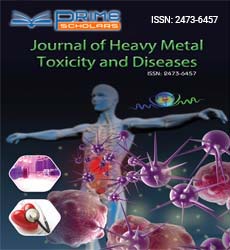Perspective - (2023) Volume 8, Issue 3
Metal Fume Fever: Unveiling the Hazards of Metal Toxicity
Warner Loss*
Department of Pharmacology and Toxicology, University of Miskolc, Hungary
*Correspondence:
Warner Loss,
Department of Pharmacology and Toxicology, University of Miskolc,
Hungary,
Email:
Received: 01-May-2023, Manuscript No. ipjhmct-23-17455;
Editor assigned: 03-May-2023, Pre QC No. ipjhmct-23-17455 (PQ);
Reviewed: 17-May-2023, QC No. ipjhmct-23-17455;
Revised: 22-May-2023, Manuscript No. ipjhmct-23-17455 (R);
Published:
29-May-2023, DOI: 10.21767/2473-6457.23.3.26
Introduction
Metal fumes are ubiquitous in various industries, playing a significant
role in the creation of essential products and infrastructure.
However, the inhalation of these fumes can lead to a condition
known as metal fume fever, a transient yet potentially dangerous
illness caused by exposure to elevated levels of metal particles.
This article delves into the realm of metal fume fever, shedding
light on its causes, symptoms, and preventive measures.
Description
Metal fume fever, also referred to as “brass founders’ ague” or
“zinc shakes,” is an acute illness that arises from the inhalation
of metal fumes, most commonly zinc, but also copper, aluminium,
and other metals. These fumes are often produced during
processes like welding, soldering, brazing, and cutting. While
metal fume fever is typically self-limiting and does not result in
long-term health issues, its symptoms can be distressing and
may mimic those of the flu. When metals are heated, their surfaces
can vaporize and form fine particles that can be inhaled.
Upon inhalation, these particles can reach the respiratory system
and be absorbed into the bloodstream. The exact mechanisms
behind metal fume fever are not entirely understood, but
it’s believed that the body’s immune response to the presence
of these particles triggers the release of proinflammatory cytokines.
This immune reaction results in the characteristic symptoms
of the condition. The symptoms of metal fume fever usually
manifest within a few hours after exposure and can last for
up to 48 hours. Common symptoms include fever, chills, headache,
muscle aches, fatigue, and a metallic taste in the mouth.
Additionally, individuals might experience coughing, shortness of
breath, and chest discomfort. The similarity of these symptoms
to those of the flu often makes diagnosis challenging, especially
if the individual’s occupation involves frequent exposure to metal
fumes. Ensuring proper ventilation in workspaces where metal
fumes are generated is crucial. Installing effective exhaust systems
helps to remove the fumes and reduce the concentration
of airborne particles. Workers should wear appropriate respiratory
protection, such as masks or respirators, designed to filter
out metal particles. The choice of respiratory protection depends
on the type of metal being worked with and the extent of exposure.
Workers should practice good personal hygiene, including
washing hands and face before eating, drinking, or smoking.
This reduces the chances of ingesting metal particles that might
have settled on the skin. Workers should be educated about the
risks associated with metal fume exposure and trained in proper
safety procedures. Awareness about symptoms can aid in early
detection and timely medical intervention. Whenever possible,
employers should explore methods to minimize exposure to metal
fumes. This might include using alternative processes or automating
certain tasks to reduce the need for manual intervention.
Conclusion
Metal fume fever serves as a reminder of the potential hazards
associated with occupational exposure to metal fumes. While
the condition is usually short-lived and reversible, its symptoms
can be debilitating and impact a worker’s productivity and
well-being. Implementing effective preventive measures, such as
proper ventilation, the use of protective equipment, and raising
awareness among workers, is essential in ensuring their safety
and health in metal-related workplaces. By prioritizing safety and
maintaining vigilant practices, industries can continue to harness
the power of metals while safeguarding the well-being of their
workforce.
Citation: Loss W (2023) Metal Fume Fever: Unveiling the Hazards of Metal Toxicity. J Heavy Met Toxicity Dis. 08:26.
Copyright: © 2023 Loss W. This is an open-access article distributed under the terms of the Creative Commons Attribution License,
which permits unrestricted use, distribution, and reproduction in any medium, provided the original author and source
are credited.

